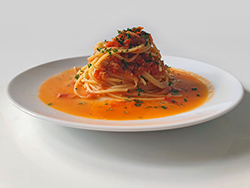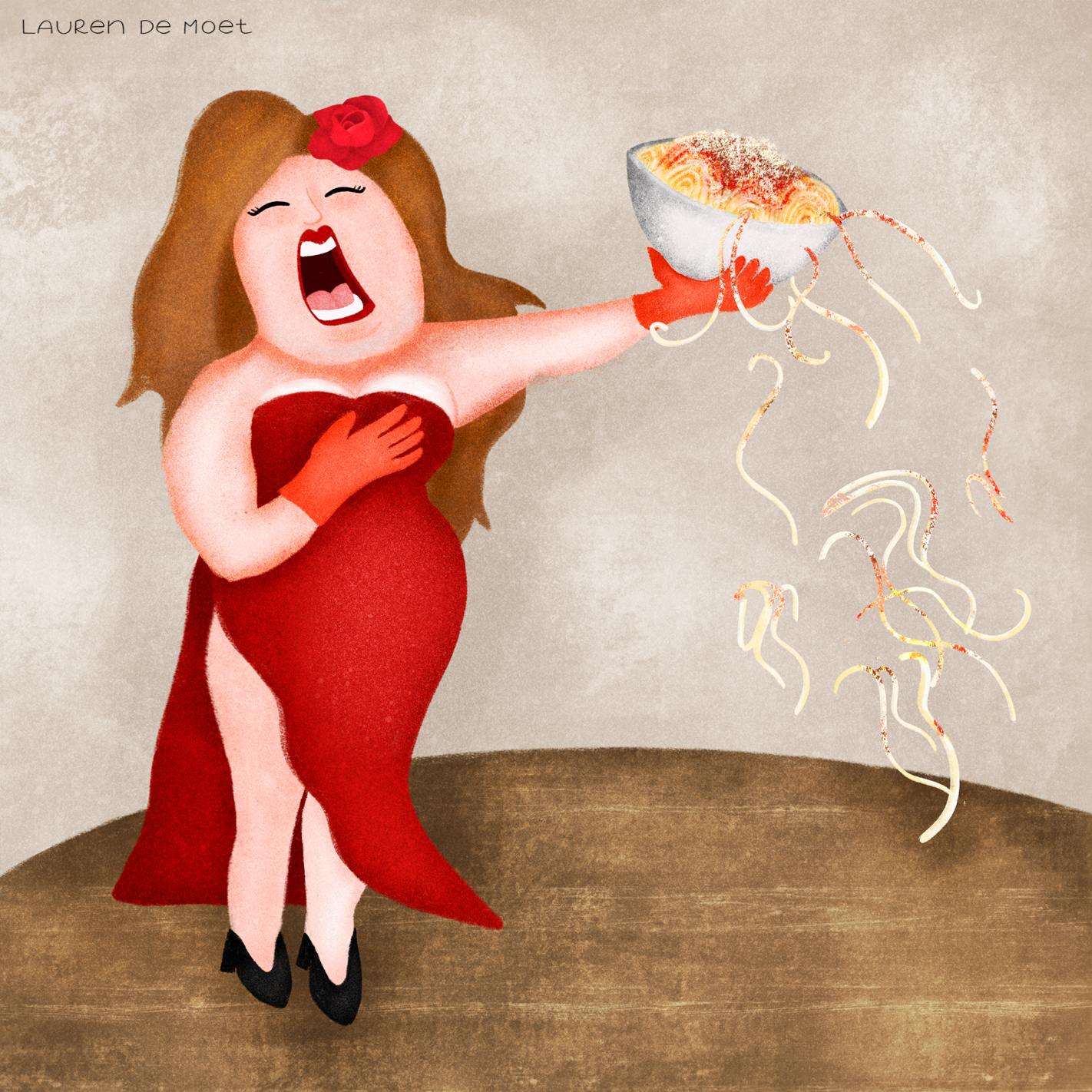
Our time-travelling sojourn with the meta-nonna proved to be incredibly productive.
Through Alvisi and Artusi, we’ve ticked off the most important direct influencers of the modern day bolognese. We’ve also had a front row seat at the tomatofication of Italy, and sampled this through our Maccheroni alla Napoletana. The conclusion being that tomatoes and spaghetti really do represent “the true taste of Italy”, at least from an Englishman’s perspective.
After all we’ve seen, I think it is fair to describe Artusi’s as the closest we have to an “original bolognese”. An original built on prime cuts of meat, no tomatoes and served with pasta resembling modern day macaroni.
So, given the Italian’s resistance to change when it comes to their cuisine, how did we get from Artusi’s original to the bolognese we know today?
It’s time to go back to the future (actually, back to 1982) to put l’Accademia’s tagliatelle al ragù alla bolognese under the microscope once more.
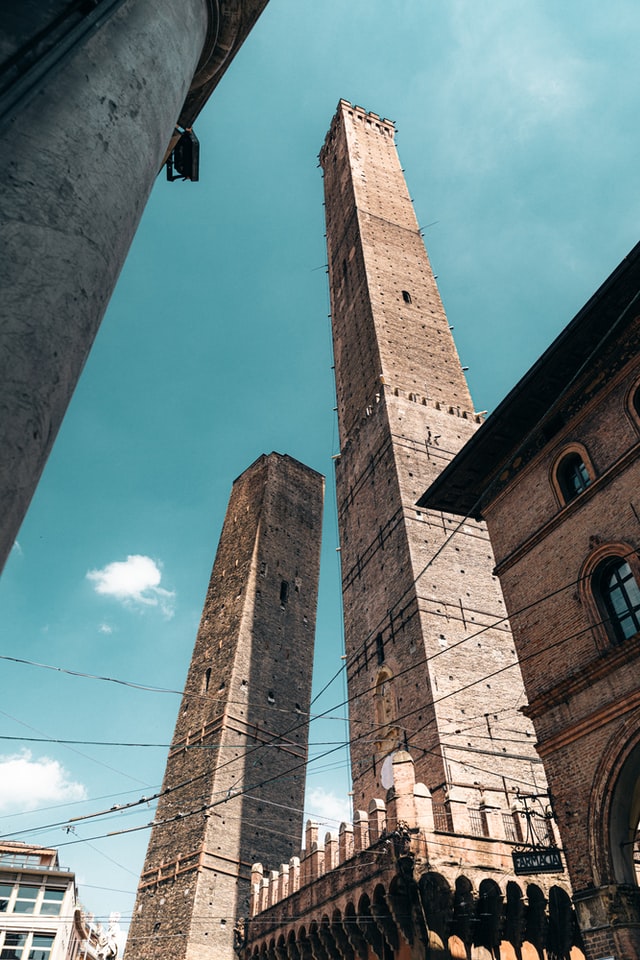
When we faithfully recreated this classic we held back a few of the historic details. L’Accademia’s recipe was not the instant hit you might have imagined it to be. According to Lynne Rossetto Kasper in The Splendid Table, local Bolognan press was lit with heated debates over the validity of l’Accademia’s sauce.
Everyone had an opinion of why it was wrong, especially the Bolognan restaurateurs, who took great offence to having not been consulted.
L’Accademia’s defence was an interesting one. Forget what Alvisi or Artusi told us - they were men of privilege. The real origin of the dish was the humble farmer, who’d had a much harder time making ends meet.
Despite their access to livestock, meat was still an expensive and rare treat. Farmers would keep a hagged old cow for milk, and when the cow was getting long in the tooth and short in its output, they would ask for one final sacrifice to keep those farm hands satiated.
An old cow had tough chunks of meat and none were tougher than the cow’s diaphragm, so a long and slow cook of this austere cut was called for.
To make the beef go further the sauce was filled out with vegetables (soffritto plus tomatoes) and pancetta (which was a much cheaper meat at the time).
The farmer’s influence also explains the dairy content. An early form of ultra-heat treatment (UHT) would result in a thick cream residue which was scraped off pasteurised milk. That residue could add depth to a sauce and reduce the need to add much in the way of a highly prized brodo.
I can understand why this recipe pissed people off. It bears very little resemblance to the “original” bolognese we saw from Artusi.
As a keen diner on the main streets and down the back alleys of Bologna, Artusi would have eaten bologneses prepared similar to his recipe in many establishments. If he hadn’t, why would he have chosen this as the bolognese for his book? It’s likely there were family restaurants that served bolognese to Artusi himself and has passed down, through generations, the same dish in the same way 103 years later when l’Accademia told them they’d been doing it wrong all this time.
I do wonder if l’Accademia had experienced a little bit of outside pressure. Allow me a moment to indulge in a conspiracy theory of my own creation. It might help explain how this version of the dish got anointed.
If we compare our Spag Bol experience with that of our Maccheroni alla Napoletano, the former is just a supercharged version of the latter. Sugar, garlic and beef mince all that separates the Italian classic with our very un-Italian Dolmio.
In David Gentilcore’s book Pomodoro, we’re told how poor Italians, mostly from the south, emigrated to the Americas. These immigrants, who would go to bed hungry in their homeland, suddenly find themselves surrounded by an abundance of cheap meat. Beef, often in the form of meatballs, was added to Napoletana sauce, because why not?
With the southern-Italianisation of America in the early half of the 20th century, followed by the Americanisation of the world in the latter part of the century, the Napoletana style of tomato sauce was taking over. It was eating non-Italian recreations of “bolognese” from the inside out, until all that remained was the name.
By the early 1980’s “bolognese” anywhere outside of Italy meant a rich, tomatoey, herby sauce poured over minced beef. I don’t believe for a second that l’Accademia were not acutely aware of this.
Imagine the consequences of l’Accademia backing Artusi’s tomato-free “original”, of veal filets, pancetta, soffritto and not much else. It would have been rejected outright by a now global audience.
The humble farmer’s bolognese served two masters. A traditional interpretation for Bolognans and a close enough match for what the rest of the world already associated with the bolognese taste.
How much substance there is to this theory is not really any of my concern - I’m not one to let the truth get in the way of a good yarn. All I can say is that l’Accademia did the right thing.
The bolognese they created, which was subsequently rejected by many in Bologna, is a vast improvement over Artusi’s, which was in turn a vast improvement over Alvisi’s.
These iterative improvements are the way cuisine is supposed to evolve.
Which leads us to a poignant question. Have we managed to convince our Italian compatriots that change in cuisine is a good thing?
I’m going to stick my neck on the chopping block and say “yes”.
If we have managed to convince them change is a good thing, can we also convince them that spaghetti is a reasonable replacement for tagliatelle when it meets with bolognese?
I’m going to quickly remove my neck from the chopping block, but have a go at this one anyway.
There are two key defenses the likes of Virgino Merelo will employ to convince you spaghetti bolognese is an abomination.
The first is that spaghetti is not the right shape of pasta for the sauce, and the second falls back to the tried and tested “we’ve always done it this way” argument. Let’s examine both in turn.
The shape of pasta does indeed change the complexion of each mouthful of a dish. The argument goes that tagliatelle is the right tool for the job because the chunks of beef mince are more likely to stick to the pasta and so each forkful will deliver a right mix of pasta and sauce. I can take this argument in one of two ways.
The first counter argument is that I have evolved from the great apes, and possess opposable thumbs that can dexterously work with the tools of modern day man. I may not have the same finesse as Donetello, Michelangelo or any of the other great Italian artists, but I am pretty good with a fork. If I want to shovel an equal amount of spaghetti and ragù, I don’t generally consider this to be an unachievable feat.
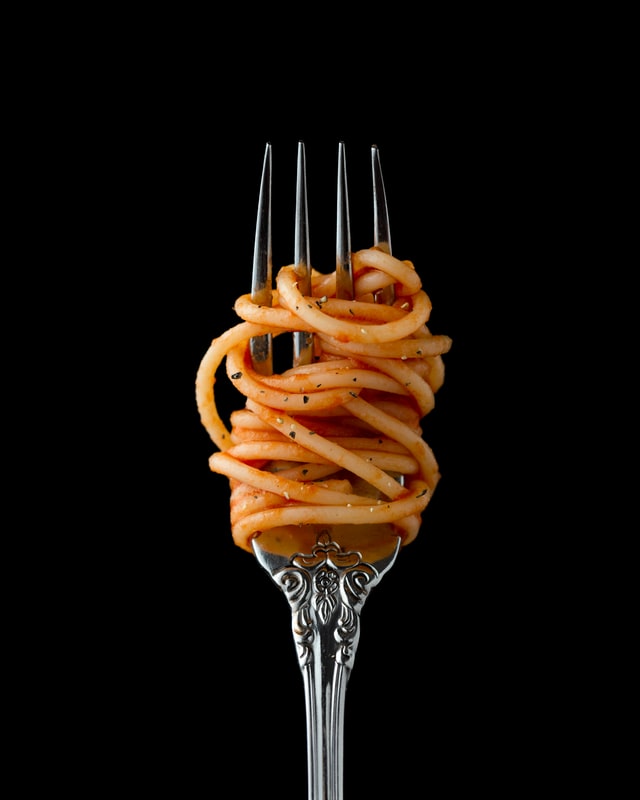
The second counter argument is more reductionist. If tagliatelle is a better shape than spaghetti for delivering bolognese, then why stop there? Pappardelle presents an even lower risk of ragù loss. Follow this to its ultimate conclusion and lasagne reduces the risk even further but a bite-sized piece of ravioli stuffed with bolognese eliminates the risk entirely. Yet ravioli is not generally considered the best way to deliver bolognese.
As we all should know by now, logic is not the best way to convince an Italian about food. Tradition is the trump card, so we should dig a little deeper here.
Spaghetti Bolognese
The rise in popularity of Spaghetti Bolognese everywhere except Italy prompted a rise in ferocity of Italian scorn on the subject.
We’ve already heard from Virginio Merola and his “fake news” outburst. Our very own Italian import, Antonio Carluccio, dismisses the dish as a British invention (although there’s no yellow carrot in his tagliatelle with bolognese sauce. Just saying.) And when Ryanair tried to tempt punters to Bologna by associating the city with spaghetti bolognese, the twittersphere collectively held up a sign saying “not welcome here”.
However, there was a growing subculture of Bolognans who could no longer turn a blind eye to all the spaghetti bolognese bashing. It did exist in Bologna and it had done for centuries.
Amongst the most vocal of these spaghettiphiles was one of Bologna’s own, Piero Valdiserra. The ex-marketing executive knew a thing or two about grabbing people’s attention. Not only did he have an abundance of evidence on the subject, but he also had personal experience. He’d grown up eating spaghetti bolognese.

Piero Valdiserra - “Eating spaghetti bolognese while smoking cigars and enjoying fine wines. That’s my only vice."
He decided to put pen to paper and released the book (to be honest, it’s more of a pamphlet):
As you might expect, the book received mixed reviews. Those who were still red-faced from shouting down the suggestion spaghetti bolognese was a legitimate dish were hardly going to change their opinions now they were presented with facts.
But the fuse had been lit. Valdiserra gave a voice to the crackpots who dared to challenge the establishment.
In 2016 a new collective was formed, headed up by lawyer Gianluigi Mazzoni and chef Stefano Boselli:

Gianluigi Mazzoni
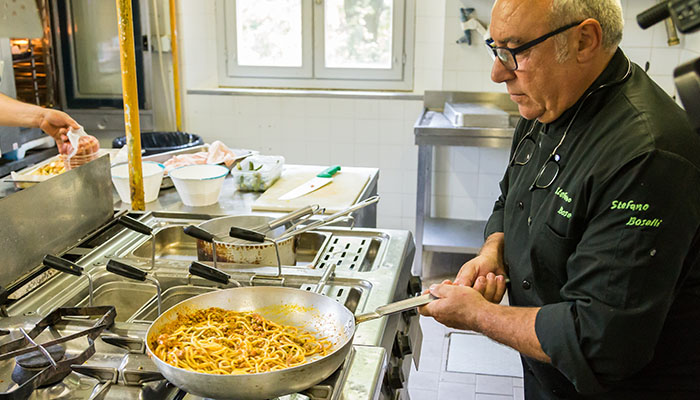
Chef Stefano Boselli
Neither Valdiserra nor il Comitato make claims of spaghetti bolognese being a replacement for tagliatelle al ragù alla bolognese. Quite the contrary. If you’re given a choice, take the latter. “Choice” being the key distinction here though, because spaghetti bolognese was historically peasants food.
Peasants didn’t eat tagliatelle every day of the week. That was the reserve of noblemen. To the city’s poor tagliatelle was a treat, saved for holidays and, if the lira allowed, as a Sunday family special. At any other time, a ragù would have been cheap, cheerful and mixed with durum wheat spaghetti.
Valdiserra calls his dish “spaghetti alla bolognese” but his recipe is nothing but a regurgitation of l’Accademia’s 1982 recipe. Il Comitato, however, propose their own version of the dish which they give the name “spaghetti bolognesi”. Both names translate to the same thing.
Here is il Comitato’s recipes in full:
Spaghetti Bolognesi
Ingredienti:
- 200 g di pancetta macinata
- 300 g di pasta di salsiccia
- 300 g di macinato di maiale
- 200 g di cartella di manzo
- 300 g di piselli
- 3 cucchiai di concentrato di pomodoro
- 2 carote medie
- 3 gambi di sedano
- 1 cipolla dorata media
- 1 noce di burro
- 2 cucchiai di olio Evo
- 1 bicchiere di vino rosso
- sale e pepe quanto basta
Preparazione:
Tritare gli odori finemente e farli soffriggere in padella con il burro e l’olio Evo, fino a farli appassire. Aggiungere la pancetta macinata e farla soffriggere, poi mettere il rimanente della carne e rosolarla.
Sfumare con il vino, lasciare evaporare e cuocere a fuoco medio per un’ora e mezza. Se serve, aggiungere un bicchiere d’acqua.
Diluire poi il concentrato di pomodoro in una tazza con poca acqua calda e aggiungere al ragù. Inserire anche i piselli poi aggiustare di sale e di pepe.
Dopo aver portato il tutto a temperatura, serviranno altre due ore di cottura. Condire gli spaghetti, che possibilmente dovranno essere di Gragnano.
Spaghetti Bolognese
Ingredients:
- 200 g of minced pancetta
- 300 g of sausage meat
- 300 g of minced pork
- 200 g outside skirt of beef (cartello di manzo / harami)
- 300 g of peas
- 3 tablespoons of tomato paste
- 2 medium carrots
- 3 celery stalks
- 1 medium onion
- 1 knob of butter
- 2 tablespoons of olive oil
- 1 glass of red wine
- salt and pepper to taste
Preparation:
Finely slice the onion, carrots and celery and fry them in a pan with the butter and olive oil, until they are soft. Add the minced bacon and fry it, then add the rest of the meat and brown it.
Deglaze with the wine, allow to evaporate and cook over medium heat for an hour and a half. If necessary, add a glass of water.
Dilute the tomato paste in a cup with a little hot water and add to the sauce. Also, add the peas and season with salt and pepper.
After bringing everything to temperature, it will take another two hours of cooking. Season the spaghetti which should preferably be from Gragnano.
There are a few things that stand out to me here.
My first observation: this ragù is not a million miles off l’Accademia’s. Soffritto, butter, pancetta, red wine, even the beef is cartello di manzo. The remainder of the sauce is filled out with pork products and there’s a good reason for this.
As we’ve previously mentioned, pork in northern Italy has traditionally been the cheapest of meats, and makes a very competent substitute for beef mince, so when we see a high percentage of pork we can associate the ragù with austerity.
According to il Comitato, spaghetti bolognesi was often prepared with the leftovers of a more lavish, beef filled ragù from the holiday feast, or from those special Sundays. The low beef content of this recipe is representative of those zdore stretching a meal over several days.
Remember, l’Accademia already played the austerity card with their “humble” farmer’s ragù, so it should not be too much of a surprise this version is similar.
My second observation of spaghetti bolognesi is the pea content, which came as a complete surprise to me. It’s not that peas aren’t naturally associated with the region. The Splendid Table cookbook has a handful and they are consistent with what’s on l’Accademia’s website.
Anguille alla Comacchiese con Piselli (Braised Eels with Peas) and Piselli con Prosciutto di Parma (Sweet Peas Parma) being two of the more famous Emilia-Romagna recipes.
I’ve never seen peas in a bolognese though. My first thought was that some nice frozen peas, thrown in at the very end of cooking, could add an interesting al dente freshness to the sauce, but reading through the recipe you can see they’ve really gone for it. Peas are added to the sauce before a further two hours of cooking.
Dio mio!
School dinner peas!
I am concerned about what will remain of these sad peas after a slow cook but once again, I will reserve judgement for the tasting notes. It is possible that the pea-preparation norms we now take for granted weren’t communicated down to the peasant classes of Bologna.
I guess by comparison, the peasant classes of Britain are eating deep fried doner meat and chips.
My third observation: we are recommended Gragnano Spaghetti. Gragnano is a region of Naples which is prized for its pasta.
When it comes to food, Italy is similar to a supermarket, with each region being an aisle.
Need the best balsamic vinegar? That’s aisle 7 - Modena. The most sought after lardo? Aisle 5 - Colonnata. Spicy salami? Aisle 2 - Calabria.
These delicacies are normally protected and strict rules cover their production. Pasta di Gragnano is no different.
In order to earn the seal, the pasta must be produced in the area, but will also require a minimum protein content of 13% (compared to the 11.5% of equivalent pastas). The high levels of protein come from the high quality of durum wheat in the region. If you recall from Artusi’s horse’s teeth pasta, the protein comes from the gluten. More gluten results in a better taste and a firmer texture.
Although not explicit in the recipe, Il Comitato’s website mentions a special pasta they had commissioned for this project, from a pasta factory in Ferrara. The special pasta had a 20% egg content, which we are told results in a capacity to soak up more sauce, due to its porous nature.
I haven’t been able to find this egg-spaghetti variant on our shores, so will be sticking with the pasta di Gragnano, which can be purchased online. I could make my own, but as homemade egg tagliatelle is ruled out for being too much of a nobleman’s fancy, it doesn’t seem quite right to replace it with an equally decadent alternative.
My fourth and final observation: this is going to be our most expensive dish yet!
Despite its status as a peasant’s food it contains a fair number of ingredients which are hard to find in the UK. I have a large batch of pancetta remaining from previous outings, but getting the real stuff was toppy to say the least. Harami (aka outside skirt, or cartello di manzo) is sold only by specialists. Gragnano Spaghetti is considered artisan. Italian sausage meat is no doubt cheap in Italy, but I’ll be paying a high price for the equivalent.
This had better taste good! (peas, I’m looking at you!)
l’Accademia
With all the hard work and research of the spaghetti bologineri can we assume l’Accademia welcomed this culinary discovery?
Let’s remind ourselves of their stated objectives:
La cucina è una delle espressioni più profonde della cultura di un Paese: è il frutto della storia e della vita dei suoi abitanti, diversa da regione a regione, da città a città, da villaggio a villaggio. La cucina racconta chi siamo, riscopre le nostre radici, si evolve con noi, ci rappresenta al di là dei confini.
È frutto della tradizione e dell’innovazione e, per questo, da salvaguardare e da tramandare.
Cooking is one of the deepest expressions of a country’s culture: it is the result of the history and life of its inhabitants, different from region to region, from city to city, from village to village. The kitchen tells who we are, rediscovers our roots, evolves with us, represents us beyond the borders.
It is the result of tradition and innovation and, therefore, to be safeguarded and handed down.
Spaghetti bolognese does represent the country’s culture and is borne from the history and life of its inhabitants.
It captures a history of hardship and a life of frugality, but this should be no less celebrated by a country whose inhabitants have fought through their fair share of adversity.
Unfortunately, l’Accademia were having none of it. In interviews, Gianluigi Mazzoni of il Comitato describes how l’Accademia have been against their movement from the start.
The party line is still that ragù alla bolognese should never, under any circumstances, be mixed with spaghetti.
I do find it interesting that l’Accademia opens the door to the poor peasant’s cow diaphragm ragù, but quickly slams it shut when the same peasants produce dried spaghetti from their back pockets.
I like to picture l’Accademia paying a surprise visit to one of those humble Bolognan farmers, with a final question about the composition of their ragù’s soffritto. As the doorbell rings, and the farmer realises who’s there, he’s frantically directing his wife to hide all the dried spaghetti so they don’t get found out.
But this was no joke to the establishment. L’Accademia were so incensed by the prospect of a spaghetti bolognese future, that they decided to cut il Comitato down with the most destructive weapon they had.
Their cookbook!
In 2018, two years after il Comitato had formally assembled, l’Accademia permanently froze out those spaghetti lovers, and crushed any prospect of them returning.
It was a Machiavellian power-play of evil genius - they filled their archives with their own recipe for spaghetti alla bolognese!
This may sound like an epic own goal, but there was smallprint, scribed by the devil’s own hands:
With what?? Tuna!?
That’s right. According to l’Accademia, the authentic spaghetti alla bolognese is prepared with tuna. Here is their recipe in full:
SPAGHETTI CON IL TONNO ALLA BOLOGNESE
Regioni:
Emilia Romagna
Ingredienti:
Ingredienti per 4 persone
- 320 g di spaghetti
- 180 g di tonno sott’olio di qualità
- 1 cipolla rosata di pezzatura normale (possibilmente di Medicina)
- 700 g di pomodori freschi (o una scatola di pelati da 400 g)
- Sale e olio q.b.
Tagliare la cipolla a fette sottilissime e farla soffriggere nell’olio fino a che diventi trasparente. Unire i pomodori, pelati e tagliati a tocchetti, e lasciare cuocere a fuoco basso per una mezz’ora circa, fino a quando si sono completamente amalgamati. A 10 minuti dalla fine cottura aggiungere il tonno scolato e sbriciolato in pezzi grossolani. Intanto cuocere al dente gli spaghetti, su cui si verserà il condimento dopo averli scolati.
Varianti ammesse
Due le varianti che è possibile ammettere: l’aggiunta di un tocco di sapore dato dalle acciughe (anche con le cipolle) o dal prezzemolo, cosparso con misura sul piatto già preparato.
Categoria:
Pasta, riso e polenta
SPAGHETTI BOLOGNESE WITH TUNA
Regions:
Emilia Romagna
Ingredients:
Ingredients for 4 people
- 320 g of spaghetti
- 180 g of quality tuna in oil
- 1 red onion of normal size (preferably from Medicina)
- 700 g of fresh tomatoes (or a 400 g tin of peeled tomatoes)
- Salt and oil to taste
Cut the onion into very thin slices and fry it in the oil until it becomes transparent. Add the tomatoes, peeled and cut into chunks, and cook over low heat for about half an hour, until they are completely mixed. At 10 minutes from the end of cooking add the drained and crumbled tuna into coarse pieces. Meanwhile cook the spaghetti al dente, on which you will pour the sauce after having drained them.
Variations allowed
Two variants that can be admitted: the addition of a touch of flavor given by anchovies (also with onions) or parsley, sprinkled with measure on the prepared dish.
Category:
Pasta, rice and polenta
Wow.
The world screams for spaghetti bolognese and this is what we get. After reading this recipe you may share the same sense of disappointment as me.
I’ve created similar ensembles throughout my student and single life. Spaghetti, tomato sauce (or quite often pesto) and tinned tuna was always known to me as “tuna surprise”. It was a bed fellow of the equally imaginative “sausage surprise”.
What’s the surprise?
After the 1,000th time of eating, absolutely nothing. But before we pass judgement, let’s at least hear l’Accademia out, because there is a bit of a backstory here.
Catholicism isn’t the world’s strictest religion, but when the church wants you to feel guilty, there are a few tools at their disposal. JC died on a Friday, and as an act of penance, followers are expected to refrain from meat each week. The same rule extends to Christmas eve.
As penance goes, it strikes me as more of a minor inconvenience than a real expression of repentance for wrongdoing, especially when compared to a vow of celibacy or silence. The catholic church considered “meat” to mean flesh from a warm blooded animal, so fish is allowed (presumably lizard too?)
According to l’Accademia, from the start of the 20th century, this resulted in a Bolognan tradition of consuming Spaghetti con il tonno alla bolognese on such holy days. Tinned tuna was expensive at the time, so the poor ate this as a treat on Christmas Eve, whereas the rich might eat this dish on any given Friday.
I’m not one to nitpick religious doctrines (kidding - I actually live for this), but tuna and sharks are fish with relative superpowers. They are able to regulate the temperature of some areas of their body, so you can argue they are luke-warm blooded and qualify as meat under catholic rules. Even if you disagree and decide tuna isn’t meat, I’d say you’re making quite a passive aggressive statement to your God by eating l’Accademia’s “bolognese”.

If I can’t persuade you to reject this monstrosity on religious grounds, we could try historic ones.
Both Valdiserra and Mazzoni rubbish the idea that spaghetti con il tonno alla bolognese is Bolognan.
Yes, it is eaten in Bologna. Yes, it has become a tradition on Christmas eve. But the city has no exclusive claim over this dish.
Look at the ingredients list for another of the most influential Italian cookbooks, Ada Boni’s “Il Talismano della felicità” (“The Talisman of Happiness”) and the recipe for “Spaghetti al tonno” (“Spaghetti with tuna”):
SPAGHETTI AL TONNO
Ingredienti
per 6 persone:
- Spaghetti, gr 600
- Acciughe, 3
- Tonno sott’olio di ottima qualità, gr 200
- Olio, mezzo bicchiere
- Aglio
- Pomodori, kg 1
- Origano
- Sale
- Pepe
SPAGHETTI WITH TUNA
Ingredients
for 6 people:
- 600g Spaghetti
- 3 Anchovies
- 200g Tuna in oil of excellent quality
- Half a glass of Oil
- Garlic
- 1kg Tomatoes
- Origano
- Salt
- Pepper
This is recognised as a Roman dish, and shares more than a slight resemblance to spaghetti con il tonno alla bolognese.
Which city can claim rights over the first incarnation is, in my opinion, irrelevant. It’s so generic, so obvious, and clearly a product of increased globalisation.
European tinned tuna (the majority of which is caught off the coasts of Spain and France), combined with fresh tomatoes (by this point, grown on an industrial scale all over Italy) served with spaghetti (which had cemented its place as the mass produced, convenience pasta of choice).
The city of Bologna is also home to several McDonalds, which I’m sure churn out millions of burgers a year, but that doesn’t make the Big Mac a local delicacy.
Before we bring this discussion to a close, we should take a step back for a moment.
Without all the context we’ve had up to this point, I’d actually expect this dish to be quite tasty. It’s going to be very similar to our spaghetti alla napoletano, just with the addition of protein.
The problem though - it is not spaghetti bolognese!
